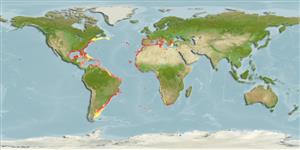Preferred temperature (Ref.
115969): 13.9 - 27.3, mean 22.5 (based on 492 cells).
Phylogenetic diversity index (Ref.
82804): PD
50 = 0.5625 [Uniqueness, from 0.5 = low to 2.0 = high].
Bayesian length-weight: a=0.00741 (0.00478 - 0.01150), b=3.03 (2.90 - 3.16), in cm Total Length, based on LWR estimates for this species & (Sub)family-body (Ref.
93245).
Trophic level (Ref.
69278): 3.9 ±0.63 se; based on food items.
Resilience (Ref.
120179): Medium, minimum population doubling time 1.4 - 4.4 years (Preliminary K or Fecundity.).
Prior r = 0.60, 95% CL = 0.39 - 0.90, Based on 6 stock assessments.
Fishing Vulnerability (Ref.
59153): Moderate vulnerability (42 of 100).
